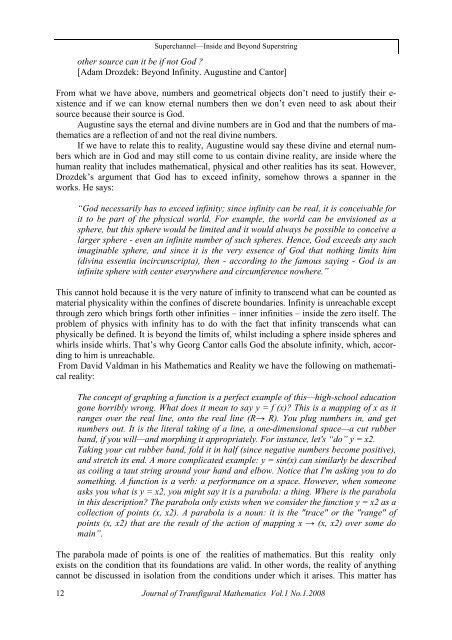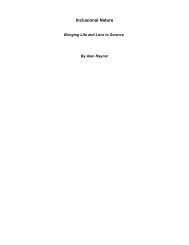JTfM Vol 1 No 1 2008 - ONLINE EDITION - Inclusionality Research
JTfM Vol 1 No 1 2008 - ONLINE EDITION - Inclusionality Research
JTfM Vol 1 No 1 2008 - ONLINE EDITION - Inclusionality Research
You also want an ePaper? Increase the reach of your titles
YUMPU automatically turns print PDFs into web optimized ePapers that Google loves.
Superchannel—Inside and Beyond Superstring<br />
other source can it be if not God ?<br />
[Adam Drozdek: Beyond Infinity. Augustine and Cantor]<br />
From what we have above, numbers and geometrical objects don’t need to justify their e-<br />
xistence and if we can know eternal numbers then we don’t even need to ask about their<br />
source because their source is God.<br />
Augustine says the eternal and divine numbers are in God and that the numbers of mathematics<br />
are a reflection of and not the real divine numbers.<br />
If we have to relate this to reality, Augustine would say these divine and eternal numbers<br />
which are in God and may still come to us contain divine reality, are inside where the<br />
human reality that includes mathematical, physical and other realities has its seat. However,<br />
Drozdek’s argument that God has to exceed infinity, somehow throws a spanner in the<br />
works. He says:<br />
“God necessarily has to exceed infinity; since infinity can be real, it is conceivable for<br />
it to be part of the physical world. For example, the world can be envisioned as a<br />
sphere, but this sphere would be limited and it would always be possible to conceive a<br />
larger sphere - even an infinite number of such spheres. Hence, God exceeds any such<br />
imaginable sphere, and since it is the very essence of God that nothing limits him<br />
(divina essentia incircunscripta), then - according to the famous saying - God is an<br />
infinite sphere with center everywhere and circumference nowhere.”<br />
This cannot hold because it is the very nature of infinity to transcend what can be counted as<br />
material physicality within the confines of discrete boundaries. Infinity is unreachable except<br />
through zero which brings forth other infinities – inner infinities – inside the zero itself. The<br />
problem of physics with infinity has to do with the fact that infinity transcends what can<br />
physically be defined. It is beyond the limits of, whilst including a sphere inside spheres and<br />
whirls inside whirls. That’s why Georg Cantor calls God the absolute infinity, which, according<br />
to him is unreachable.<br />
From David Valdman in his Mathematics and Reality we have the following on mathematical<br />
reality:<br />
The concept of graphing a function is a perfect example of this—high-school education<br />
gone horribly wrong. What does it mean to say y = f (x)? This is a mapping of x as it<br />
ranges over the real line, onto the real line (R→ R). You plug numbers in, and get<br />
numbers out. It is the literal taking of a line, a one-dimensional space—a cut rubber<br />
band, if you will—and morphing it appropriately. For instance, let's “do” y = x2.<br />
Taking your cut rubber band, fold it in half (since negative numbers become positive),<br />
and stretch its end. A more complicated example: y = sin(x) can similarly be described<br />
as coiling a taut string around your hand and elbow. <strong>No</strong>tice that I'm asking you to do<br />
something. A function is a verb: a performance on a space. However, when someone<br />
asks you what is y = x2, you might say it is a parabola: a thing. Where is the parabola<br />
in this description? The parabola only exists when we consider the function y = x2 as a<br />
collection of points (x, x2). A parabola is a noun: it is the "trace" or the "range" of<br />
points (x, x2) that are the result of the action of mapping x → (x, x2) over some do<br />
main”.<br />
The parabola made of points is one of the realities of mathematics. But this reality only<br />
exists on the condition that its foundations are valid. In other words, the reality of anything<br />
cannot be discussed in isolation from the conditions under which it arises. This matter has<br />
12<br />
Journal of Transfigural Mathematics <strong>Vol</strong>.1 <strong>No</strong>.1.<strong>2008</strong>




